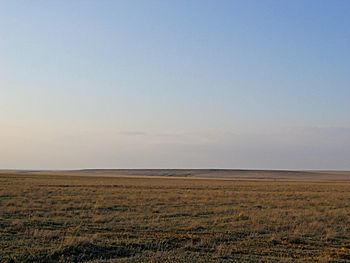Steppe facts for kids

A steppe is a large, flat area of land that has very few trees. You might see some trees near rivers or lakes, but mostly it's just open land. It's a bit like a short-grass prairie, which is what these areas are often called in North America. Steppes are mostly found in eastern Europe and central Asia. Places like this in Africa are called savannas. The biggest steppe in the world, sometimes called The Great Steppe, is located in Russia.
The Mongolian Steppe, also known as the Eastern Steppe, is in northern Mongolia. It stretches between the Altai Mountains in the west and the Greater Khingan Region in the east.
Climate and Landscape
Steppes can look different depending on the season and where they are located. Some parts might be like a semi-desert, while others are covered with grass or shrubs. The climate in a steppe is usually too dry for a thick forest to grow, but it's not dry enough to be a full desert.
The soil in a steppe has more moisture than a desert, but not enough for many trees. Steppes get a little more rain than deserts do. The weather in steppes is usually mild, or "temperate," but it's still quite dry because there isn't much rain.
Life on the Steppe
Steppes are wide-open spaces, and it can be a long way between places with good water. Because of this, many people who lived in these areas were nomads. This means they moved from place to place, often traveling by horses, to find food and water for their animals.
A famous warrior named Genghis Khan came from Mongolia and lived on the steppe. Many people in the Mongolian steppe today are still nomads. Families often live in "gers," which are large, round, portable tents. Mongolians are also amazing horse riders, and many families own lots of horses that roam freely across the steppe. People living on the steppe use the animals for food and drink. They also have a very rich musical culture with many traditional Mongolian songs.
In the United States, cowboys used to herd cattle across similar open lands. They also moved from place to place on horseback. During the 1930s, a time called the Dust Bowl, farmers in North America faced big problems. They had recently started farms on the land, but a long drought meant their crops failed. Many farmers had to leave their homes. Over time, they learned new ways to farm and plant crops that could survive dry weather better. They also learned to plant rows of trees, called windbreaks, to protect their fields from strong winds.
Images for kids
-
Steppe in Russia
-
Southern Siberian steppe: windbreaker trees in the wintertime
-
Cold Patagonian steppe near Fitz Roy, Argentina
-
Prairie in Alberta, Canada
-
Sagebrush steppe in northeastern Nevada along US 93
See also
 In Spanish: Estepa para niños
In Spanish: Estepa para niños






